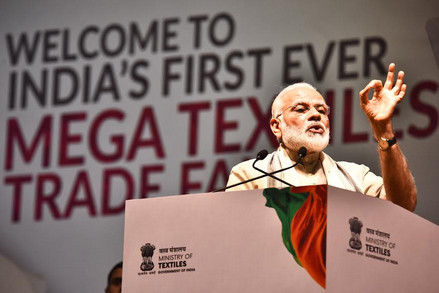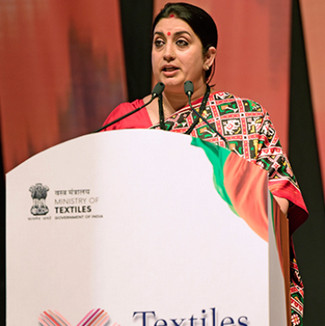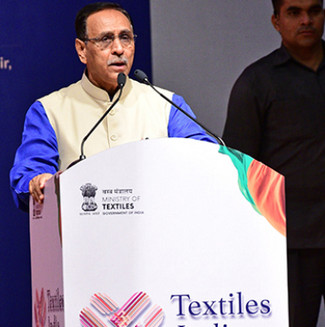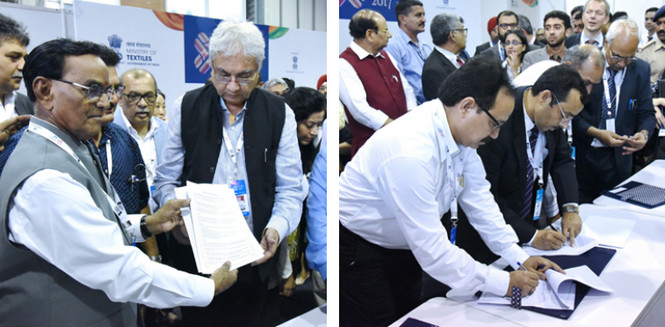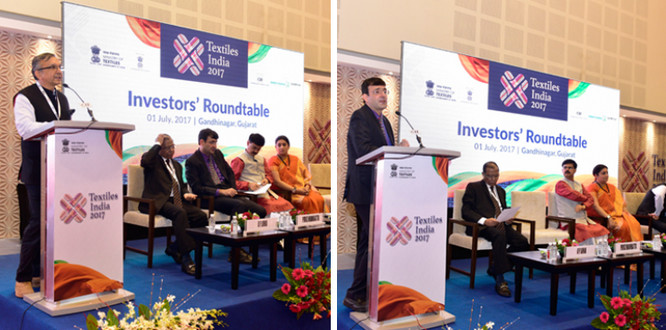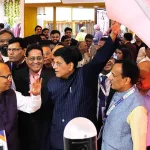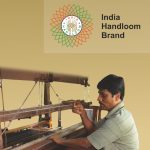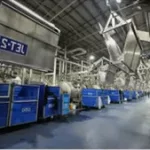Full text of PM Modi’s speech at the Textile India 2017 event is reproduced below:
Ladies and Gentlemen,
India is today described as a bright spot in the global economy. It has emerged as one of the most attractive global investment destinations. This has been made possible by a series of sustained policy initiatives.
More than seven thousand reforms have been implemented to improve the ease of doing business. Processes have been simplified and made transparent. Government has repealed over twelve hundred outdated laws. These are just a few examples.
Consequently, India has moved up by thirty two places in the last two years in the Global Competitiveness Index of the World Economic Forum. This is the highest for any country. India moved up nineteen places on the World Bank Logistics Performance Index of 2016. We have also moved up sixteen places on the Global Innovation Index of the World Intellectual Property Organisation in 2016. We are third among the top ten FDI destinations listed by the United Nations Conference on Trade & Development.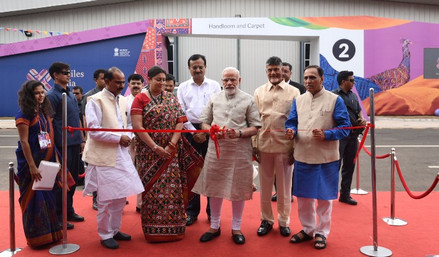
Based on the “Make-in-India” initiative, the organized textile industry is being infused with the mantras of ‘skill, scale, speed’ and ‘zero-defect, zero-effect’ for scaling up employment, production and exports.
We have one of the most liberal investment policies for foreign investment in the textile and apparel sector. We allow 100 percent FDI through automatic route in textile and apparel sector.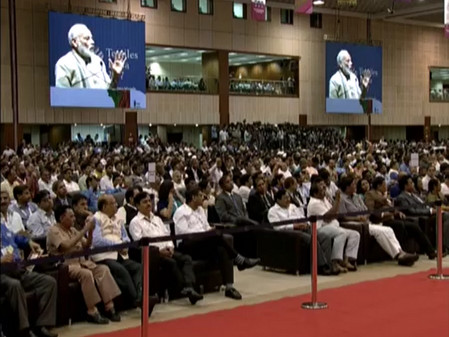
The textiles industry has a pivotal position in the Indian economy. It is strong and competitive across the value chain. India has an abundant supply of raw material, like cotton, wool, silk, jute, and man-made fibre. In fact, it is the world’s largest producer of cotton and jute, and second largest producer of silk and man-made fibre. This provides us the distinct advantage of backward integration, which many other countries may not have. In addition, India has strong spinning, weaving, knitting and apparel manufacturing capacities. Young, skilled labour is available at a reasonable cost.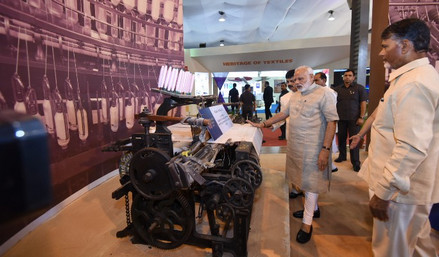
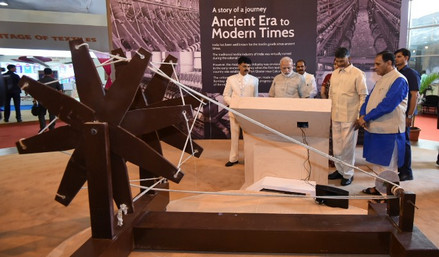 Our high economic growth has resulted in higher disposable income. The resulting higher demand for products offers a huge domestic market. Ours is a nation of aspirational youth, who wish to spend on textiles, apparel, and handcrafted lifestyle products. The domestic market for apparel and lifestyle products, currently estimated at $ 85 bn, is expected to reach $160 bn by 2025. This growth will be driven by the rising middle class.
Our high economic growth has resulted in higher disposable income. The resulting higher demand for products offers a huge domestic market. Ours is a nation of aspirational youth, who wish to spend on textiles, apparel, and handcrafted lifestyle products. The domestic market for apparel and lifestyle products, currently estimated at $ 85 bn, is expected to reach $160 bn by 2025. This growth will be driven by the rising middle class.
There is also a high global demand for textiles and apparel manufactured in our country. India is the world’s second largest exporter of textiles, commanding a global share of around five percent. Indian textiles, including traditional handloom and handicraft products, are exported to more than a hundred countries. Sometimes, Indian tourists buy garments abroad, only to realize later, that they have been made in India. The textile sector offers significant employment opportunities. It is today, our second largest employer after agriculture. Over forty-five million people are employed directly in the sector, and over sixty million people are employed in allied activities.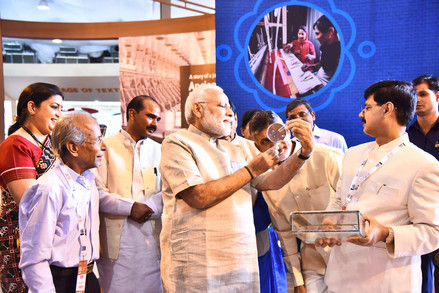
An integrated skill development scheme is also being implemented to address the critical gap of skilled manpower, through industry-oriented training programs.
Our strengths in manufacturing and export are backed up by our ability to develop world-class training and research institutes. The National Institute of Fashion Technology has a network of sixteen professionally managed campuses. It has been playing a crucial role in benchmarking performance and processes in the areas of fashion education, research and development, training and consultancy.
In the last few years we have witnessed a very healthy competition amongst States to attract investment and industries in their respective States. As a result, there have been some major reforms that have taken place in States. Each State in its own way has tried to facilitate the establishment of new industries including textiles. I think, the time has now come for us to concentrate on textile exports in a big way.
India is a country with diverse culture, fashion and traditions. This diversity is clearly reflected in the clothing present in different regions. We should catalogue and map our clothing diversity and clearly earmark strengths and specialties of each state or region. Each State should appoint nodal officers dedicated to a few well-known products, who would facilitate producers and traders across the value chain. The intervention should start from production to export of garments. It should meet the specific requirements of domestic as well as export markets.
We should also formulate an action plan to study and map the requirements of people in large global markets and monitor new trends in fashion and textiles in these areas on a real time basis. Government Councils and Industry Bodies should rise to the occasion, in a spirit of cooperation. This would enable us to channelize our energies in meeting those requirements and give a boost to our exports.
Innovation and research are new mantras for growth and wealth generation. The textile industry will have to constantly innovate and research for growth and to tap new markets. For example, physiques may be larger in some parts of the world. This may require clothing of greater width than the normal size used in our country. For this, you may need to increase the width of the loom. Elsewhere, requirements may be different. Such attention to detail is necessary to attain leadership in export markets.
Today, there is a demand for products with zero carbon footprint. Holistic lifestyle has become a buzzword. The market for Organic Dyes, clothes and fabrics made of organic products is growing. Our effort should be to innovate in organic products.
Apart from cotton and jute, we already have fabrics made of banana and bamboo fibres. There is a niche market for such products. Thus, there is a need for further research by our institutions like National Institute of Fashion Technology and Scientific and Industrial Research institutes to develop fabrics from other sources.
Our integrated textile clusters are compliant to global standards of environment and health safety. Textile producing States also have pro-industry policies in place, to facilitate the required infrastructure for investments in textiles.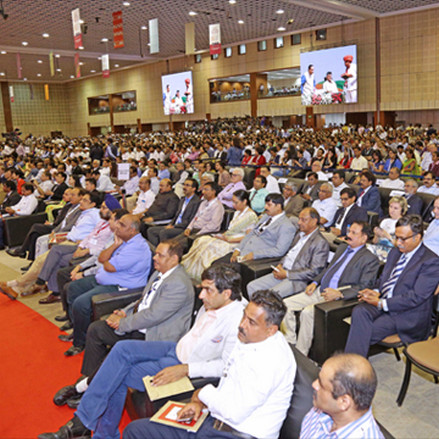
I understand that over the next two days, you would have an opportunity to interact with a few State Governments. Some of my Cabinet colleagues will also interact with you. I am sure you will find these sessions interesting and informative.
I hope this event will help familiarize global and Indian leaders with India’s enabling policy environment, strengths and vast opportunities associated with the sector. This will help establish India as a valued partner for countries seeking sourcing and investment opportunities in India. I hope, it will go a long way in realizing India’s inherent potential to become one of the most significant textile and apparel sourcing and investment destinations.
Let me conclude by wishing you a very successful and productive three days in Gandhinagar.
I call upon you to Come, Invest and Make Textiles in India.
Thank You!
Addressing the gathering, the Union Textiles Minister, Smt. Smriti Zubin Irani said that history will be created in the field of textiles today, with the success of this mega event. The Minister said that Textiles India 2017 gives fillip to Honourable Prime Minister’s dream of Make in India. She said that besides seeking to engage participants in conversations leading to strategic partnerships that encourage investments, the mega event seeks also to bring together leaders in the global textile value chain together on one platform, to envision a glorious future for the Indian textiles industry. She informed that global citizens from 106 countries, 15,000 Indian buyers and sellers, 2,500 international buyers, international delegates and representatives and artisans and weavers who enthral us with their craft have come together under one roof on this occasion. Smt. Irani said that Textiles India 2017 brings together textiles, traditions and technology. She said it compliments the Prime Minister’s desire to strengthen the entire Indian textile value chain, comprising the journey of Farm to Fibre, Fibre to Fabric, Fabric to Fashion and Fashion to Foreign.
Minister of State for Textiles, Shri Ajay Tamta, and Ministers representing Gujarat, Telangana, Maharashtra, Jharkhand, Assam and Karnataka were among several dignitaries who participated in the inaugural session.Governor of Gujarat, Shri O. P. Kohli; Chief Minister of Gujarat, Shri Vijay Rupani, Chief Minister of Andhra Pradesh, Shri N. Chandrababu Naidu and MoS, Textiles, Shri Ajay Tamta addressed the audience. Minister for Irrigation, Handloom and Textile and Sericulture, Government of Assam, Shri Ranjit Dutta; Minister for Textiles, Govt of Karnataka, Shri Rudrappa Manappa Lamani and Minister for Cooperation, Textiles & Marketing, Government of Maharashtra, Shri Subash Deshmukh and Chairman, Jharkhand State Gramodyog Board, Shri Sanjay Sheth were also present. Chief Minister of the host state Gujarat, Shri Vijay Rupani said that Gujarat is fortunate to have gotten the opportunity to host Textiles India 2017. Shri Chandrababu Naidu complimented the Ministry of Textiles for organizing the event, saying that the textiles sector will continue to survive for times to come.
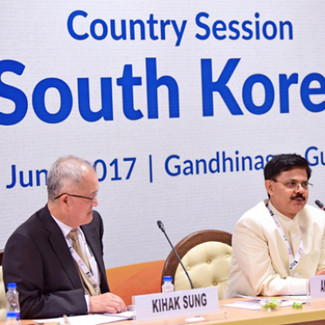 Several captains of the industry were also present on the occasion, including President, US Polo association, Mr. David Cummings; CEO, UK India Business Council, Mr. Richard Heald; MD, Arvind Mills, Shri Sanjay Lalbhai; Chairman and MD, Raymond, Shri Gautam Hari Singhania; Chairman, Aditya Birla Group, Shri Kumar Mangalam Birla and Chairman of Korea Federation of Textile Industries (KOFOTI), Mr. Kihak Sung.
Several captains of the industry were also present on the occasion, including President, US Polo association, Mr. David Cummings; CEO, UK India Business Council, Mr. Richard Heald; MD, Arvind Mills, Shri Sanjay Lalbhai; Chairman and MD, Raymond, Shri Gautam Hari Singhania; Chairman, Aditya Birla Group, Shri Kumar Mangalam Birla and Chairman of Korea Federation of Textile Industries (KOFOTI), Mr. Kihak Sung.
Textile India 2017: Valedictory Function
Nine Union Ministers Dwelt on Strategies to Strengthen the Textiles Sector of the country, at ‘Textiles India 2017’ in Gandhinagar, Gujarat on the last day of the event on July 2, 2017.
Detailed discussions were held on the concluding day of the three-day mega trade fair, held at Gandhinagar.
In his valedictory address, the Minister for Information & Broadcasting, Urban Development, Housing and Urban Poverty Alleviation, Shri M. Venkaiah Naidu said that the Government is committed to make India a global textiles and apparel manufacturing hub; he said the Government will continue to work in close collaboration with industry and academia, to ensure that the textile sector flourishes. Shri Naidu said that the Government had brought in several enabling policies and schemes in the manufacturing sector, particularly in textiles, to make India the no. 1 manufacturing hub. He highlighted that considering the potential of the sector to create employment, attract investment and increase exports, the Government approved a special package for apparel sector in June 2016, and a special package for made-ups in December 2016. He said Textiles India 2017 has successfully managed to demonstrate India’s strength as a sourcing and investment destination of the world.

Valedictory Address by Shri M. Venkaiah Naidu @ Textile India 2017 on July 2, 2017 at Gandhinagar, Gujarat. Others seen in the picture are (L-R): MoS, Textiles, Shri Ajay Tamta, Smt. Irani, Vice Chairman, NITI Aayog, Dr. Arvind Panagariya and Secretary, Textiles, Shri Anant Kumar Singh
The Minister said that as the younger generation wants a change in speed, various measures are being taken promptly. He pointed out all people of the country are happy with the introduction of GST.
In his address, Vice Chairman, NITI Aayog, Dr. Arvind Panagariya said that the textiles and clothing industry has a great potential for creating good jobs. He added that Textiles India 2017 has been a momentous occasion for giving a fillip in this direction.
In her address, the Textiles Minister Smt. Smriti Zubin Irani said that Textiles India 2017 has proved that textiles sector was the sleeping giant that is now roaring as the “Make In India” lion. She added that the outcomes of the event should lead from one milestone to another, in achieving the objectives of making India the leading textile manufacturing hub.
MoS, Textiles, Shri Ajay Tamta too addressed the valedictory session. The event proceedings at Mahatma Mandir came to a close with a vote of thanks by Secretary, Textiles, Shri Anant Kumar Singh. The Textiles exhibition at Helipad Ground, Gandhinagar was open till 10 PM.
Seven conferences were held earlier in the day, consisting of one global conference of ASEAN countries and six national conferences, on various topics concerning the textiles sector.
Productivity and Product Diversification Challenges for Natural Fibres

Agriculture Minister Shri Radha Mohan Singh, who chaired the session on “Productivity and Product Diversification Challenges for Natural Fibres”, speaking on the occasion.
As chair of the national conference on “Productivity and Product Diversification Challenges for Natural Fibres”, Agriculture Minister Shri Radha Mohan Singh said that natural fibres are the backbone of Indian textile industry. He noted that natural fibre production involves million of farmers and the industries using them create rural jobs. Shri Singh said that despite stiff competition from synthetic fibres, the demand for natural fibres is steadily increasing with a growing population.
The Minister said that given the limitation in increasing area under cultivation, the only way to improve production is increasing productivity. He said that introduction of high-yielding varieties, best agronomical practices, efficient fibre extractors and effective utilization for diversified products will improve productivity. He said that this is the right time for all stakeholders to discuss and formulate a suitable strategy to increase productivity of all natural fibres. The Textiles Minister added that steps will be taken for regular exchange of information, knowledge and best practices between the two ministries.
Potential of Man-Made Fibres in India

Union Minister for Chemicals and Fertilizers and Parliamentary Affairs, Shri Ananth Kumar, who chaired the session on “Potential of Man-Made Fibres in India”, speaking on the occasion.
Chairing a session on “Potential of Man-Made Fibres in India”, Union Minister for Chemicals and Fertilizers and Parliamentary Affairs, Shri Ananth Kumar said that man-made fibres are gaining wide applications in both conventional and technical textiles. He said that considering the global shift towards man-made fibres, India is focusing to establish itself as a supplier of quality man-made textiles and apparel for the global market. The Minister highlighted the major opportunities for investment in MMF textiles to be in the following broad areas: import substitution, growing segments in international trade and domestic market opportunities. He added that a group will be formed for synergy between his Ministry and Ministry of Textiles, for addressing challenges and opportunities jointly.
Exploring Growth Potential of Technical Textiles in building India

Union Minister for Road Transport, Highways and Shipping, Shri Nitin Gadkari, who chaired the session on “Exploring Growth Potential of Technical Textiles in building India”, speaking on the occasion.
A session chaired by Union Minister for Road Transport, Highways and Shipping, Shri Nitin Gadkari was held on “Exploring Growth Potential of Technical Textiles in building India”. Addressing the gathering, the Minister said that geosynthetic fibers have huge potential in the construction of roads and ports in the country, adding that it must be cost-effective and done without compromising on quality. Shri Gadkari said that the problems of the country are different from region to region; he said that we should hence encourage innovation, research and entrepreneurship. The Minister said that converting knowledge into wealth is the most important need of the future. MoS for Textiles, Shri Ajay Tamta said that his ministry is committed to provide innovative textile technology to various sectors like agriculture, defence, health, sports construction and environment.
India as a Sourcing Hub and Investment Destination

Union Minister for Commerce & Industry, Smt. Nirmala Sitharaman, who chaired the session on “India as a Sourcing Hub and Investment Destination”, speaking on the occasion.
Sharing her thoughts as Chair of a session on making India a sourcing hub and investment destination for the world, Union Minister for Commerce & Industry, Smt. Nirmala Sitharaman recounted the historical fact that the Indian textile sector had attained global eminence long before many other sectors could establish themselves. Noting that India itself is a very big market, the Minister said that the industry needs to tap opportunities in both domestic as well as international markets. She said that at every stage of the 5-F formula given by the Prime Minister, India is the best sourcing platform. She highlighted the importance of interest subvention in lowering the cost of capital for the industry. Smt. Sitharaman said that GST is going to be a big blessing for the sector. Noting that the strength of the sector lies in its niche areas, the Minister highlighted the need for greater creativity in the industry. Addressing some questions from industry representatives, the Minister spoke of the need to convert challenges into opportunities, and reminded them that India has taken a principled position to have a duty-free and tariff quota restriction – free relationship and trade with LDCs.
NITI Aayog CEO Shri Amitabh Kant highlighted the importance of size and scale, as well as agility and speed to market, innovation & digitization of the entire supply chain of the textile sector.
Skilling Requirements in High Value Chain in Textiles Sector

Union Minister for Skill Development and Entrepreneurship, Shri Rajiv Pratap Rudy, who chaired the session on “Skilling Requirements in High Value Chain in Textiles Sector”, speaking on the occasion.
The session on skilling was chaired by the Union Minister for Skill Development & Entrepreneurship, Shri Rajiv Pratap Rudy. The Minister said that Skill India is an integral part of both Make in India and Textiles India. Shri Rudy said that a key question facing the skill sector is that of creating a basic first-level skilling ecosystem in the country. Citing examples of various beneficiaries, the Minister highlighted the need for short-term skilling programmes, and formal interventions for skilled manpower. He said that work is being done in this direction by his Ministry, to address the questions of how, for whom, where, curriculum, content, examination, certification and employment as it relates to the skilling requirements of the country. Noting that the largest employment among the organized workforce is in the textiles sector, the Minister asserted his confidence in building a robust skilling ecosystem in the country, in line with the vision of the Prime Minister.
Minister of State, Textiles, Shri Ajay Tamta said that the 65 MoUs signed during Textiles India 2017 will contribute towards improving the skilling scenario in the textiles sector.
Carving a Niche Market for Indian Handcrafted Goods

Union Minister for Culture and Tourism, Dr. Mahesh Sharma, who chaired a parallel session on “Carving a Niche Market for Indian Handcrafted Goods”, speaking on the occasion.
Chairing another parallel session, Union Minister for Culture & Tourism, Dr. Mahesh Sharma said that our rich heritage and culture is our identity & strength and that the motive of today’s conference was to explore how we can take this rich heritage of the country to all corners of the world. Regarding GST, Dr. Sharma said that the Government of India has taken a historic step in the field of taxation, due to which no artisan or craftsman of our country will henceforth face any partiality regarding tax on their products. He detailed the initiatives his ministry has taken to give unique identity to each and every artisan, craftsman and artist of the country.
ASEAN Conference
A global conference of ASEAN countries was also held. Delegates from all ASEAN countries participated in the conference which had two sessions, one on “Building value chains in Textile Sector” and another on institutional framework for promoting collaboration in textiles between India and ASEAN countries.
Renowned national and international speakers from different fields shared their thoughts during the above conferences. Mr. Gautam Nair, MD, Matrix Clothing; Mr Christain Schindler, Director General, International Textile Manufacturers Federation (ITMF); Dr. Rohana Kuruppu, CEO, Brandix College of Clothing Technology; Mr. Richard McCallum, MD, UKIBC; Mr. Philip Mc Goldrick, International Technical Director, Strata Geosystem; Prof. Ing Thomas Chairman, ITA; Ms Rosy Greenleese, President, World Craft Council; Prof. Abdul Jabbar Khan, Bangladesh Univ. of Engg. & Technology (BUET), Dhaka; Dr. Li Long, Professor in Sericulture Research Institute, Chinese Academy of Agricultural Sciences, China and Mr. Y. J Kim, Senior Consultant, Asia PTA DMT Polyesters are some amongst them.
Chief Minister of Gujarat, Shri Vijay Rupani, Chief Minister of Andhra Pradesh, Shri N. Chandrababu Naidu and Ministers representing Gujarat, Telangana, Maharashtra, Jharkhand, Assam and Karnataka attended the event.
“Kabir himself used to weave cloth and dye it and was known to look for life’s truth through his work and expressed the same through his couplets. Clothing has close links to our cultural diversity and so many places and cities are well-known due to the textile industry they have. Be it silk from Kanchipuram, Varanasi and Assam or pashmina from Kashmir, muslin of Bengal, chikan work of Lucknow, handwoven ikkat work of Odisha and Telengana, Patan’s Patola from Gujarat or shawls from Kutch — from centuries these textile tradition have given an identity to these regions. You will never find this diversity in any other nation.”
For Textiles India 2017, 15,000 Indian buyers & sellers, 2,500 foreign buyers, delegates and representatives from 106 countries, and artisans and weavers from all parts of India had come under one roof. The event brought together textiles, traditions and technology in line with the Prime Minister’s desire to strengthen the entire Indian textile value chain, comprising the journey of Farm to Fibre, Fibre to Fabric, Fabric to Fashion and Fashion to Foreign.
